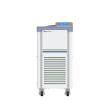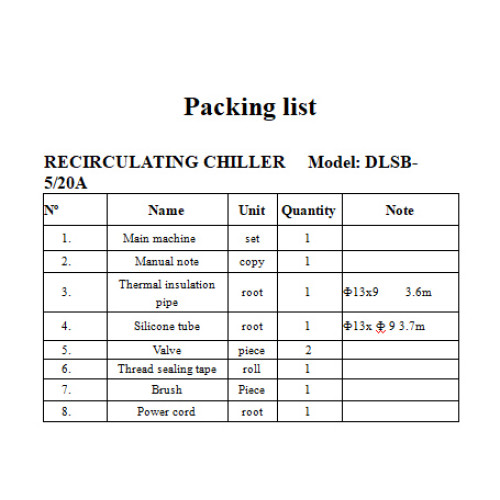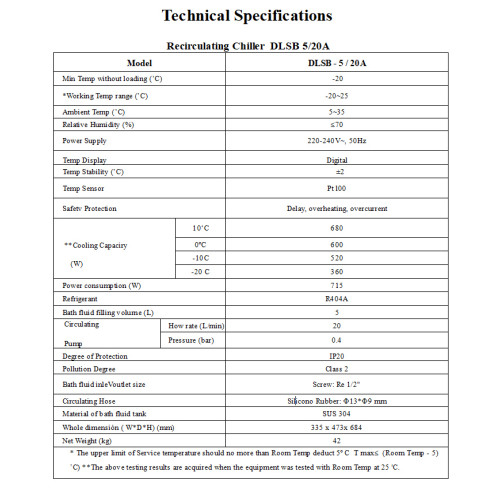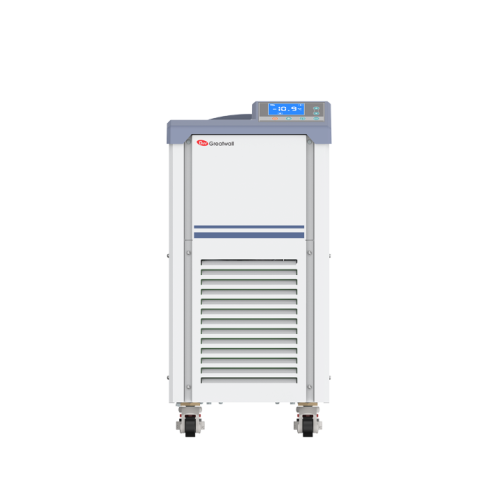Recirculating chiller DLSB-5/20A
3~ 380V/50Hz
Cooling capacity : 5 l/min
Refrigerant: R404A
Ambient temperature (ºC): 5~35
*Working temperature range (ºC): -20~25
Filling with bath liquid: 40L
Pump flow rate: 30 l/min
Temperature stability: ±2℃
Pump pressure: 1 bar
Hose connection size: 3/4''
*The upper limit of operating temperature should not exceed room temperature minus 5º CT max≤ (room temperature - 5) 'C)
DLSB-5/20 Circulation Chiller is a low-temperature liquid circulation equipment. The compression cooling equipment can cool the reaction bottles, have a chemical reaction at low temperatures, and store chemical and biological products at low temperatures. In addition, the chiller chiller can be combined with rotary evaporator, vacuum lyophilizer, multi-purpose water circulation vacuum pump. The chiller adopts air cooling by a closed compressor. High-quality cooling with high speed greatly improves the working efficiency. It has digital temperature display, microcomputer control, which is easy and simple to operate. Relays, protective devices, capacitors and other devices inside the cooling unit are of high quality.
- Link
- Price
- Availability
- Quantity
- DLSB-5/20A
- 1,398.00€
- 8
-
-
Sub-Zero Temperature Control with the DLSB-5/20A
You know those moments when you're running a rotary evaporator and standard tap water cooling just won't cut it? That's where the DLSB-5/20A comes in. It's a recirculating chiller that'll take your cooling bath down to -30°C, which honestly makes a huge difference when you're dealing with low-boiling solvents or need faster condensation rates.
I've seen labs pair this unit with the Rotary evaporator R-1020CE and Rotary evaporator R-1050CE for solvent recovery work, and it handles those setups without breaking a sweat. The 20-liter tank capacity gives you enough thermal mass to maintain stable temps even when your rotovap's running full tilt.
Achieving -30°C to 5°C Cooling Range
- Operating range: -30°C to 5°C lets you tackle cryogenic applications that'd be impossible with standard chillers
- Temperature stability: ±2°C keeps your processes consistent across long runs
- R404A refrigerant system: Pulls temps down fast and holds them there reliably
- Digital LED display: Real-time monitoring so you're not guessing what's happening inside
The pump pushes 20 L/min at 0.4 bar, which is plenty for most single-instrument setups. If you're comparing this to the Recirculation cooler DL30-300CE, that one's got a bigger 30-liter capacity but similar cooling performance—just depends on whether you need the extra volume.
Compatible Applications for Rotary Evaporators
Solvent recovery is the obvious use case here. When you're condensing dichloromethane or acetone, colder condenser temps mean way better recovery rates and less solvent escaping into your vacuum pump. I've also seen people use these for:
- Cooling jacketed reactors during exothermic reactions
- Temperature-controlled spectroscopy cells
- Material testing chambers that need sub-ambient temps
- Freeze-drying prep work before transferring to the lyophilizer
For labs running multiple rotary evaporators simultaneously, you'd want to step up to the Recirculating chiller DL30-700CE or Recirculating chiller DL30-1000CE with their higher capacities and multi-port distribution.
Compact Recirculation Design Features
Dimensions: 335 x 473 x 684 mm means it'll fit on a standard lab bench without hogging all your workspace. At 42 kg, you can move it yourself if needed—though I'd still grab a colleague to help lift it onto the bench.
The stainless steel tank resists corrosion from coolant additives, and the hermetic sealed compressor runs pretty quietly for shared lab spaces. Standard 220-240V power means no special electrical work required.
Quick maintenance tip: Clean those air intake filters weekly during heavy use. Dusty filters kill cooling efficiency faster than anything else. Check your coolant levels monthly too—evaporation happens even in closed systems.




